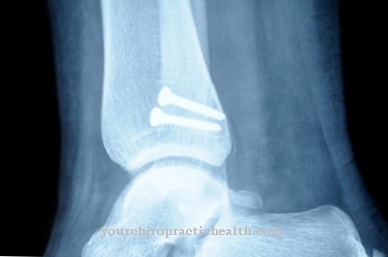The Amelogenesis is the formation of tooth enamel, which is carried out in two phases by the ameloblasts. A secreting phase is followed by a mineralizing phase that hardens the tooth enamel. Tooth enamel formation disorders make teeth more prone to tooth decay and inflammation and are often treated with crowns.
What is amelogenesis?

Tooth enamel is the hardest tissue in the human body. It surrounds the dentin and has a protective function. There is a large amount of enamel, especially in the area of the tooth crowns. Around 97 percent of the body's own substance consists of inorganic substances such as calcium or phosphate. Only about three percent of tooth enamel is organic.
Tooth enamel is therefore often referred to as dead tissue with no regenerative capacity. This has to do with the way tooth enamel is formed, also known as amelogenesis. Amelogenesis is carried out by the ameloblasts in the crown stage of ontogenetic development. These are specialized cell types from the surface ectoderm that form the enamel and lie against the formed layer from the outside after the work is completed. After the teeth erupt, they are already chewed off. For this reason, the tooth enamel is a tissue without a variety of regenerative capabilities, such as in wound healing. However, remineralization is possible.
Function & task
Enameloblasts or ameloblasts correspond to cells with a cylindrical structure and a hexagonal cross-section. Their diameter is around four µm. They bring it to a length of up to 40 µm. They mainly secrete two proteins. In addition to the so-called enamelin, they form the amelogenin. In the course of ontogenetic development, these substances store salts and mineralize to form hydroxyapatite. In this way, they turn into tooth enamel.
At the secreting end of each ameloblast there is a wedge-like extension. This element of the cells is called the Tomes process and is responsible for aligning individual prisms in the tooth enamel. As soon as the formation of the tooth enamel comes to a standstill, all ameloblasts become squamous cells and form the border epithelium.From this point on, they no longer have the ability to divide, but lie statically against the tooth enamel on the outer layer. After the tooth eruption, they lose their authorization and are therefore lost. When the teeth erupt, they migrate bit by bit in the direction of the sulcus and at some point they reach the groove between the gum and the tooth, where they are rejected.
Amelogenesis takes place in the so-called crown stage of ontogenetic development. The formation of dentin and the formation of tooth enamel are subject to reciprocal induction. The dentin must always be formed before the enamel is formed. The amelogenesis steps just described are sometimes divided into two phases. During the secretory phase, the proteins including the organic matrix are formed, which lead to incompletely mineralized tooth enamel. Only after the subsequent ripening phase is the mineralization considered complete. In the first phase, the basic mineralization takes place using enzymes such as alkaline phosphatase.
Usually, the first mineralization occurs by the fourth month of pregnancy. The enamel formed in this phase spreads outward piece by piece. The secreting phase is now complete. In the ripening phase, the ameloblasts take on transport tasks. They transport the production-relevant tooth enamel substances to the outside. The substances transported are primarily proteins that are used at the end of the maturation phase for the complete mineralization of the enamel. The most important of these proteins are the substances amelogenin, enamelin, tuftelin and ameloblastin.
You can find your medication here
➔ Medication for toothacheComplications
Amelogenesis imperfecta is a congenital defect that destroys tooth enamel. It is a seldom occurring condition and has a variety of appearances. The detailed anamnesis helps to avoid serious complications. Even with the milk teeth there is massive abrasion and tooth loss.
Food intake is becoming increasingly difficult, painful inflammation and fever make the child suffer and language acquisition can only be poorly developed. The teeth begin to splinter, react hypersensitively to temperature differences and the symptom is often accompanied by growths on the gums and gingivitis. Differential diagnostics ensure the diagnosis and early therapeutic interventions are initiated.
This method is especially important for small children so that the dentition can develop properly. The same applies to adults who are affected by tooth loss. In addition to the loss of firmness and bite height, the aesthetic aspect comes into play here. The enamel density is measured on the basis of the X-ray examination.
Depending on the advanced stage, the teeth, in children even the milk teeth, are provided with strip or steel crowns or fillings made of plastic, all-ceramic or zirconium dioxide. This will keep them as long as possible. Amelogenesis imperfecta can put the patient in front of great psychological and physical resilience, but complications can be avoided if they are found in good time.
Illnesses & ailments
Various ailments can arise with the formation of tooth enamel. Most of these complaints are referred to as so-called enamel disorders or amelogenesis imperfecta. The cause of such malfunctions is largely unknown. The disorders usually manifest themselves in early childhood at the latest and manifest themselves in one or more teeth, which in extreme cases have little or no enamel at all.
The reason for this is the subject of speculation. Some scientists believe that malfunctions in enamel formation are primarily related to external factors. For example, it is speculated that strong infections in infancy contribute to tooth enamel disorders. The same may apply to certain medications. On the other hand, internal factors have not yet been ruled out. Genetic predispositions, for example, can be described as such. Mutations in the coding genes of the ameloblasts or the amelogenetically relevant substances cannot be excluded. So far, medicine has only agreed on the causal malfunctions of the ameloblasts.
Enamel hypoplasia makes the patient's teeth more susceptible to tooth decay and wear and tear. In addition to tooth decay, inflammation, such as inflammation of the roots, are conceivable consequences. Damaged teeth are usually crowned therapeutically in order to create a healthier appearance, chewing ability and artificial protection.
In the case of particularly severe clinical pictures after hypoplasia of the tooth enamel, a complete restoration of the dentition is required, which can result in a complete crown. The affected teeth can first be treated for the secondary disease and then sealed. Under certain circumstances, severely affected teeth with too little tooth enamel are also pulled.
If root inflammation has developed as a result of the educational disorder, a root canal treatment is carried out first. To do this, the tooth must be opened so that the affected tissue can be removed. A thorough cleaning of any root canals removes the bacteria that cause inflammation. Most often, an antibiotic drug is inserted into the affected tooth. Removal of the affected tooth should only be considered in the event of a relapse.
If the enamel formation disorder is recognized early enough and crowned, often no secondary diseases of the teeth occur.













.jpg)

.jpg)
.jpg)











.jpg)